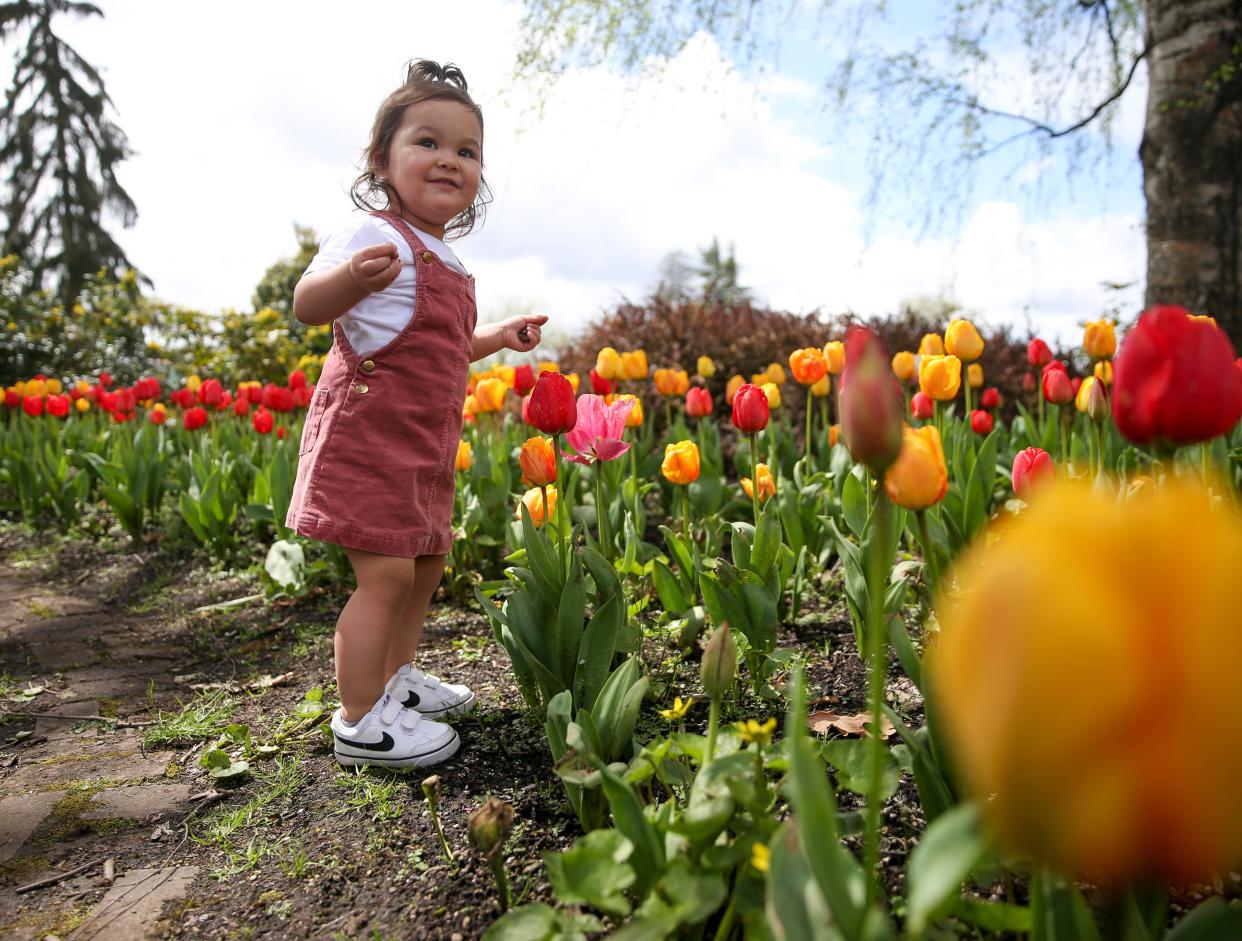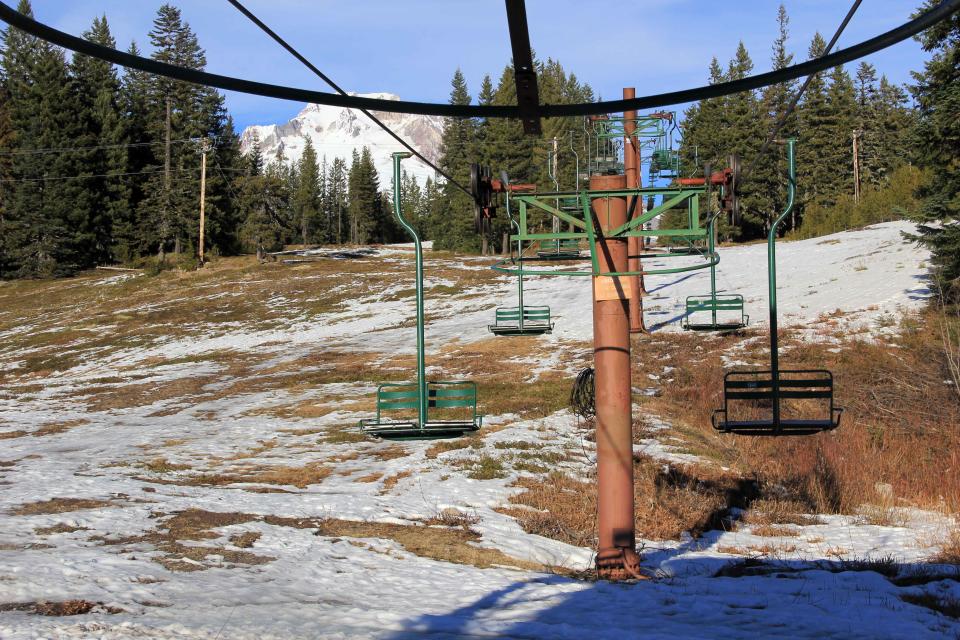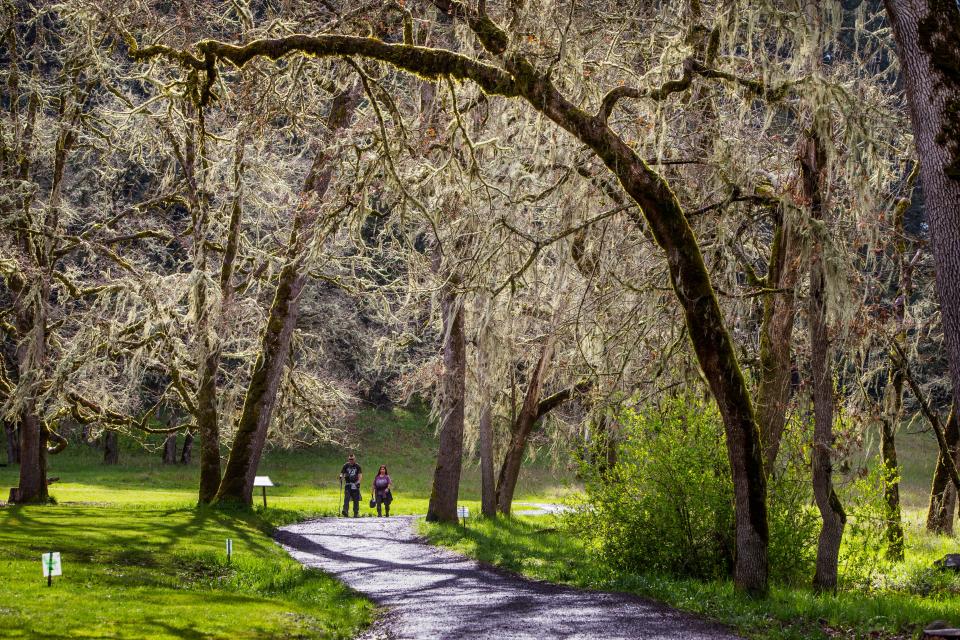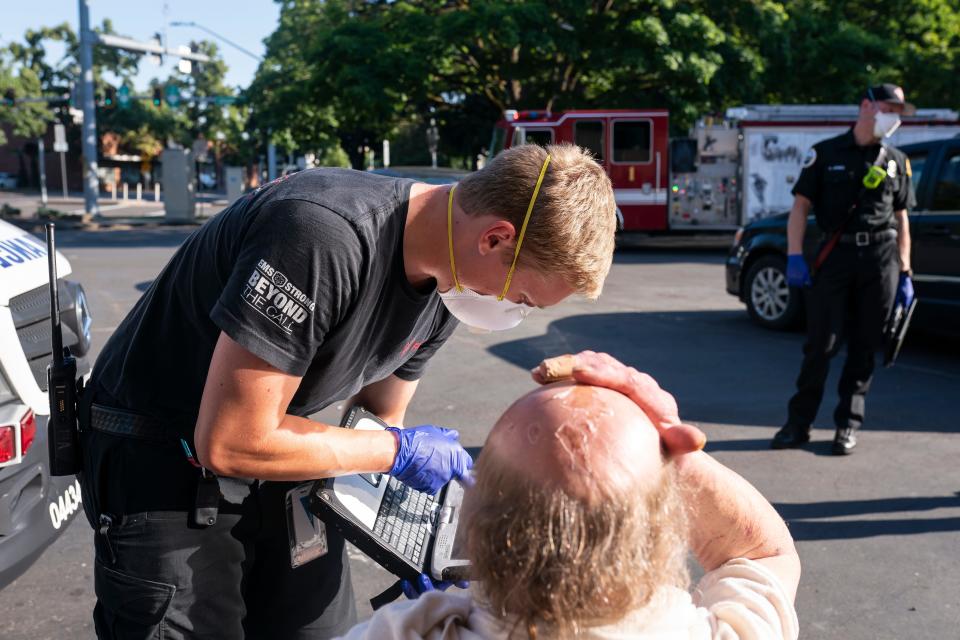Will Oregon's weather feel like California? Climatologist talks El Nino, warming future

In a few decades, the Willamette Valley might feel like California, droughts and floods could be more commonplace and 100-degree days may be par for the course.
The next year could provide a preview of what's to come.
That’s according to Oregon state climatologist Larry O’Neill, the state’s czar for studying how climate change is impacting the Beaver State.
O’Neill recently joined the Explore Oregon Podcast for a conversation about the state’s short and longer-term climate prospects.
More: Explore Oregon Podcast: Updates on Labor Day wildfires trial, forest access, hikes
O’Neill talks about the likely return of El Nino next winter and why that might lead to historically warm temperatures and lower-than-normal snowpack next winter, before diving into a long-term look at what the gradually rising temperature in Oregon means for the future.
Answers have been edited down for length and brevity. Listen to the full episode at StatesmanJournal.com/explore.
Zach Urness: Last month we wrapped up a third year of La Nina conditions — which tend to bring cooler and wetter weather than normal. Now, there’s a 60% chance of entering an El Nino pattern this summer and an 85% chance next fall and winter. There have been pretty dire predictions about what that means, particularly for warmer-than-normal temperatures, especially next winter. What does El Nino mean and why are we concerned, or why are we seeing that concerning reporting about it?
Larry O’Neill: During El Ninos, we actually get a large release of heat from the ocean into the atmosphere. That means during El Ninos, the global temperature is well above normal. And this is coinciding with this background global warming where the average temperatures are getting warmer every year. The concern is that this El Nino will be much warmer than El Ninos we've experienced in the past. The last strong El Nino we had was in 2015, and that's when Oregon set its warmest temperature on record. So, we're very concerned that this year will turn out to be much warmer than normal.
More: Oregon snowpack jumps to 172% of normal, best since 2008, could delay wildfire season
Urness: As a reporter, 2015 really grabbed my attention because it was so shockingly different than anything we’d experienced. There was barely any snow — barely a trace — in the mountains throughout the winter. I remember there being a giant lake at Hoodoo Ski Area. It was bizarre. So in the coming year, are we expecting a similar El Nino and similar impacts?
O’Neill: The forecast right now is for about an 85% chance of developing El Nino conditions going into the fall and a 62% chance of it developing this summer. If that is the case, if an El Nino develops, we have a bit higher chance of a warmer summer.
In summers leading into El Nino events, the coastal ocean off the Pacific Northwest tends to be much warmer than normal. The ocean can experience significant changes in productivity and fishery yields. For instance, salmon don't do as well in El Nino years. We may see these impacts in the late summer and fall. But the most obvious and impactful changes to our local weather in Oregon would likely come next winter.

Urness: So, I guess a selfish takeaway is that if you love skiing, you should take advantage of this nice snowpack out there because there are decent odds that next winter won't be very good snow-wise. Like, is that fair? Or is that pushing it too far?
O’Neill: No, I think that's fair. Get your turns in now.
Urness: Stepping back and looking at the wider playing field, do we have a handle on the impact climate change is having on La Nina and El Nino patterns? We've talked about its kind of amplifying things — just normal weather on steroids — but is it having any direct impact on those two patterns and when they show up, how powerful they show up and stuff like that?
O’Neill: There's some debate in the scientific community on how climate change is affecting the ENSO cycle in general — the patterns of El Nino and La Nina, and then also how they impact our weather. We just don't have long enough data records to really be confident that we know that what's happened in La Nina and El Nino years in the past are going to continue. But one thing is certain is that climate change is starting to make our weather more unpredictable. And that's especially true for precipitation — which has gotten much more erratic between seasons. Take the last two years — spring 2021 was the driest in Oregon’s recorded history and then spring of 2022 was the wettest. Those were both in similar La Nina conditions, but very different outcomes.
Urness: One story we wrote the last two years has been an overarching look at the state's temperature compared to historical records, and then some more specific observations about different locations across Oregon. Most recently, we reported that this past year, 2022, was the 10th hottest year statewide in records going back to the 1890s. That continued a string of historically hot years. Of the 13 hottest years recorded in Oregon, nine have come since 2000 and seven have come since 2010. So those are the facts. But one thing that stuck out to me is that Oregon barely ever has cold years anymore. It's only happened, I think, three times since the 1980s? You mentioned that of the last 37 years, 34 of them have been warmer than average. So, I guess the question is, has climate change locked us in to the point where it's just difficult to have a cool year? Like do you need five things to go right to get a cool year at this point?
O’Neill: Yeah, it's just this slow background warming that’s happening most places on Earth. We don't necessarily expect that we'll ever get back to having a very cold year like we had in the '50s or '60s or '70s here in Oregon. We are pretty locked into that until we reduce our concentrations of greenhouse gases.
Urness: To push back a little, one thing I hear a lot is that, even last year, it was the 10th warmest year on record, but really it was only 1.7 degrees warmer than an average Oregon year. So that's warmer, but not much warmer. It doesn't seem like a big deal, a couple degrees here and there. Why are a few degrees impactful?
O’Neill: Back in the 1930s when this link between greenhouse gas and the Earth's temperature came to being, there was this very famous cartoon of people in northern latitudes being able to sunbathe and grow crops where they couldn't before because it was too cold and things like that. And so, there was this idea that climate change might actually be good for society. By increasing our greenhouse gas emissions like this, we're running kind of a poorly designed science experiment where we're warming the planet and seeing how it affects society and natural systems on Earth. And what we're seeing that there's a lot of adverse impacts on society (even at 1.7 degrees or two degrees). There are warmer winters, less snowpack with earlier melt outs, so that really impacts our water supply, recreation and affects our wildfire risk in higher elevations. There's more invasive species in Oregon, both aquatic and grasses, that increase our fire risk and become a nuisance. We have warmer stream flows, so more harmful algal bloom, which can cause issues with water quality for our municipal and irrigation. There's more heat stress on aquatic species in the rivers and more concentration of harmful toxins in our waterways. We're getting more heat waves and heat stresses, (which) is a very strong health risk for the public. More frequent, severe and impactful droughts, which has really affected agricultural and livestock producers. We have declining groundwater supplies, especially in southern Oregon right now. I think that's kind of an overview of the observed impacts from our poorly designed science experiment.

Urness: Speaking of water, you mentioned that a few times and it’s obviously a big deal. But in the climate models played forward, while the state continues to warm, we are projected to get similar amounts of rainfall, correct? And that’s shown up in recent years, especially on the west side of the state, where we’ve had warmer than normal years, but precipitation has stayed pretty close to normal. Can you parse that out?
O’Neill: Basically, as the atmosphere warms, it can hold more water vapor. And what that means is that there's more water vapor available to condense in the clouds and form precipitation. And so just because of that, we're expecting that there's going to be either the same amount of precipitation or a little bit more on a globally average basis. When you go down to a regional scale to Oregon, the projections right now are that we’ll probably have about the same amount of rain when you average over a decade or two, but the swings between wet and dry years will be greater. We expect that the dry years will be drier and then the wet years will be wetter. What that means is that there's going to be an increased amount of impacts on both ends. So just like it's been very dry last few years, we will inevitably go into a cycle where we get much more rain than we need and there'll be more flooding concerns and things like that. And then, inevitably, we'll go into a drought year where things will just be drier than they have been before.
Urness: One thing you mentioned a few years ago that has stuck with me as a very good, but super simple way of describing it, is that Oregon is starting to feel more like California than Washington. Do you still feel like that's a good way of describing it in super simple terms?
O’Neill: I think so, yeah. In the '90s, I grew up in Sacramento, in northern or central California. And, while Oregon is not quite there yet, we are starting to feel more like far northern California. In terms of both of our temperatures and precipitation variability in another 30 or 40 years, someplace like Corvallis here will start to feel a lot more like Sacramento.
Urness: One thing to consider is that Oregon is a pretty different state. Topographically, not all places have been impacted equally. The Oregon Coast sticks out, especially during the heatwaves of recent summers. The coast hasn't been very hot compared to what we’ve seen in the Willamette Valley and especially Eastern Oregon. East of the Cascades, it's been really hot, really dry, but you get over to the coast and it's pretty close to historical averages. Do you expect that to eventually change or is the coast just kind of buffered because it's right next to the ocean and the farther you get to the east, the more you're seeing the impact?
O’Neill: That's exactly right. The coast is moderated a lot by the ocean temperatures. The ocean is expected to warm. It's a little bit uncertain how the water very close to the coast within about 50 miles or so will change. We see someplace like Seattle that is on the Puget Sound and if you look at the long-term monitoring stations, they haven't warmed as much as when you go into stations inland or to the east of the Cascades. The climate models all point to the fact that the inland areas will warm much more than in the places near the coast.
Urness: Well, it's been so striking. I mean, when we get into these heat waves during the middle of summer, everybody just wants to go to Newport because it'll be over 100 degrees in Salem, and then you look over at Newport and it's like 63 or something like that. So, I guess the idea here is buy some real estate in Newport or along the Oregon Coast.
O’Neill: Yeah, I think people are doing that.

Urness: So, one of the things everybody remembers is the 2021 heat dome — that record-setting 117 degrees in the Willamette Valley. Is it still viewed as a totally freak occurrence? Because that's kind of how it was described when it was happening. Or will situations like that become increasingly possible as we head out 5, 10, 15 years? Is that totally abnormal or is that like now within the sphere of possibility?
O’Neill: There's a general growing consensus is that it was a rare combination of a couple different elements that came together at once. Climate change did contribute to it, but it may not have caused it or been an overriding factor in the generation of the heat dome. With that said, we do expect heat waves to increase in frequency and intensity going forward and we have seen that last summer. Last summer (2022) was just as warm as the summer before (2021). Even though we didn't have the high-impact event, like the heat dome, the nights were warmer, the days were just a little bit warmer, and it was consistently warm. It was consistently in the 90s. And that is more of what we expect from climate change, just that the summers are a little bit longer, the nights are warmer, the days are warmer, but it's not necessarily getting to be, you know, 116, 117 degrees a couple times a summer.
Urness: So, we're not heading for 120 degrees, we're just heading for a super long string of 90-degree days. Where 90 starts to feel like 80 used to.
O’Neill: Yeah, that's exactly right. In 30 or 40 years, the models are suggesting that every summer we'll start to get 105- or 110-degree days, or many summers will be like that.
Urness: Anything else that sticks out? We've covered a lot of ground from wildfires to droughts to just hotter days and less snow. Anything else that sticks out to you as far as what to expect as we go forward or even just into next year?
O’Neill: One of the things that actually I spend a lot of time looking at is the impacts of climate change on soil moisture. And in Oregon, and everywhere, the amount of moisture in the soil really has a big impact on our stream flows, on the health of the vegetation, our ability to grow crops and raise livestock and our lake levels and our wildfire risk.
The very consistent signal from climate change that we expect is just drier soils year-round. And even this year's a good example. Even though the snowpack is doing quite well up in the Cascades, we have quite a few soil monitoring sites that are at or near record-low soil moisture content for this time of year. And that's just a really worrying signal, that even though we have a good snowpack, we’re not able to recharge our groundwater supplies.
Urness: One thing that I'm curious about in the long-term is that there's been a lot of talk about reducing greenhouse gases and whether we're able to do that or not. But are we baked into a level of warming for a while at this point? Like even if we threw on the brakes, wouldn't it take a while to see the impact of that?
O’Neill: Yes. Even if we were to completely go to zero carbon emission or greenhouse gas emissions, it would take about 15 or 20 years for us to see the global average temperature drop to maybe the levels that we've seen since the '90s or '80s or something like that. There is a technical term for it. It's a little bit of inertia in the system. It just means that the temperature is warming, and so it's going to just take a while for that warming to kind of slow down and stop and start to cool again. One of the reasons for that is that carbon dioxide, which is the predominant greenhouse gas that's causing our warming, stays in the air for up to 100 years on average.
The natural processes that remove carbon dioxide from the atmosphere are pretty slow. So even if we were to stop our emission of that, the concentrations are already very large in the atmosphere. But with that said, there is a greenhouse gas that contributes significantly to the warming that gets out of the atmosphere pretty quick. And that's methane. So, methane is responsible for about 25% of the average temperature rise that we're experiencing from global warming. But it has a resonance time in the atmosphere of about 20 or 25 years. So, if we can reduce our methane emissions, we can actually see a response within our lifetimes of the atmosphere. We often think of methane emission reductions as being kind of a low-hanging fruit in our response to climate change and our mitigation scenario for climate change. So, it would be a fairly good bang for our buck in, in trying to mitigate climate change, to reduce methane emissions.
Urness: What's your outlook? Are there any positive things that we can look at as far as progress? Anything positive that you can hang your hat on?
O’Neill: So, we grew up back in the early 2000s and we started to know and see that climate change was happening. It was becoming obvious in our instrumented data records. So, we were seeing it in observations, and we were starting to see the adverse impacts from that. And at that time, electric cars weren't really a thing. They were kind of a novelty and there wasn't a real good path forward. And I remember thinking at that time, with the way the world was structured, there didn't seem to be a path forward to kind of moving beyond fossil fuels.
And right now, I see that there's a lot of progress being made, so now you can go get electric cars. The technology is there that over a lifetime of the car, you're reducing emissions by a substantial amount. It isn't a lot. But it is something we now see that there's a path forward that in 10 or 20 years, there's a lot of momentum for progress. I know that there are a lot of naysayers and people who kind of view that as too little too late. But compared to where we were 20 years ago, I think there's a good path forward. And I think we just need to stay the course.
Urness: So, there's a path forward. It's just a matter of staying on the path or maybe sprinting forward?
O’Neill: Yeah. But we do need to move quicker.
Zach Urness has been an outdoors reporter in Oregon for 15 years and is host of the Explore Oregon Podcast. Urness is the author of “Best Hikes with Kids: Oregon” and “Hiking Southern Oregon.” He can be reached at zurness@StatesmanJournal.com or 503-399-6801. Find him on Twitter at @ZachsORoutdoors.
This article originally appeared on Salem Statesman Journal: Oregon climate change El Nino snowpack Cascades Coast weather

